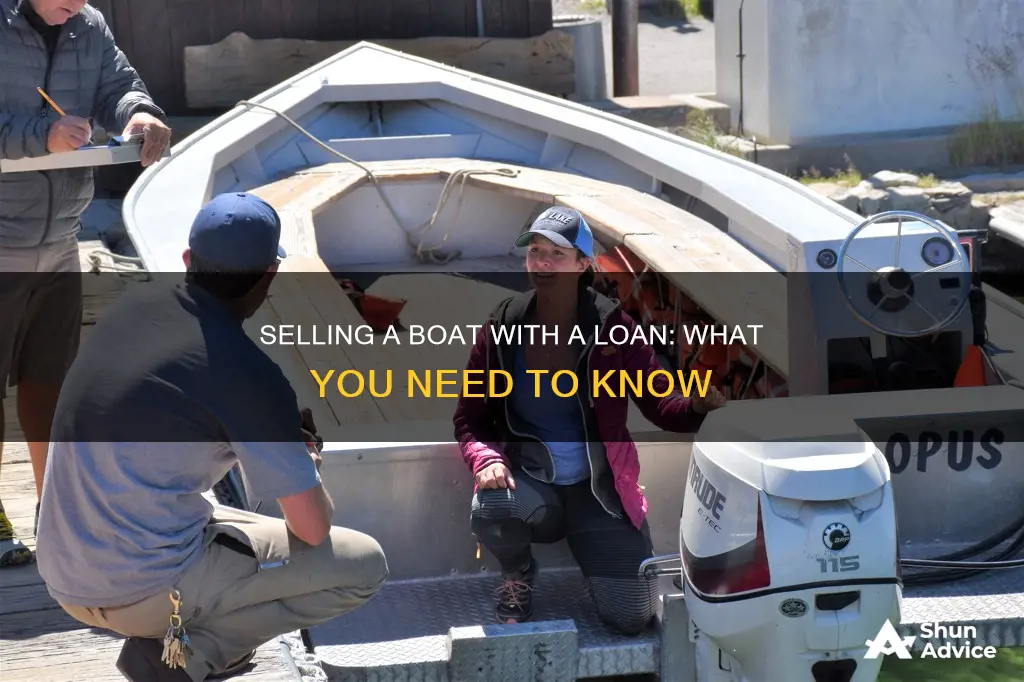
Selling a boat with a loan can be tricky, but it is possible. The first step is to contact your bank to understand the payoff amount and process. Once you know the remaining loan amount, you can decide how to pay it off. You can either pay it off yourself or use the buyer's money. If you're using the buyer's money, be transparent about the loan amount and consider accompanying them to the bank to explain the situation. You can also provide the buyer with a statement from the financial institution to reassure them. After paying off the loan, you'll receive the original title, and you can sell the boat directly to the buyer. It's important to ensure all the necessary paperwork is in order, including a bill of sale, warranty, and inspection report.
What You'll Learn

Understand the risks of selling a boat with a loan
Selling a boat with a loan on it is a fairly common occurrence, with about half of boats purchased in any given year involving loans. However, it is important to be aware of the risks and difficulties associated with this process. One key risk to consider is the potential for delays in the closing process due to the involvement of the lien holder (the bank). The bank will not release the title and lien until they are paid, which can add steps and restrictions on the timing of the closing. This includes accounting for banking hours and processing times for paperwork.
Another risk to consider is the potential for higher costs associated with the loan. Unsecured loans, which are not tied to a specific asset like the boat, often come with higher expenses. While defaulting on a secured loan can result in losing the boat, unsecured loans do not have this immediate consequence. However, the lender can pursue legal action to recover the debt, and your credit score will be affected.
Additionally, selling a boat with a loan can expose you to financial risks. If you pay off the loan before selling, you may be left strapped for cash, making it challenging to cover ongoing maintenance expenses, slip fees, and insurance until the boat is sold. On the other hand, if you rely solely on the buyer's funds to pay off the loan, there is a risk of the new owner defaulting on the loan, leaving you owing money to the bank without any collateral.
Furthermore, selling a boat with a loan can be a complex process, especially when dealing with international sales. Documentation rules, currency conversions, rate risks, and communication with foreign banks and brokers can all present challenges. It is crucial to ensure that all the necessary paperwork is in order, including surveys, title checks, and documentation of the vessel. Engaging the services of a broker or a third-party guarantor can help ensure a smooth and secure transaction.
Lastly, it is important to consider the market for your boat and the loan-to-value ratio of your outstanding mortgage. These factors can impact the ease and speed of the selling process and the potential for financial loss. Overall, while selling a boat with a loan is possible, it is important to carefully evaluate the risks and seek professional advice to ensure a successful and secure transaction.
Title Loans: Are They Legal in New York State?
You may want to see also

Prepare all the necessary documents
Preparing all the necessary documents is a crucial step in selling a boat with a loan. Here are the key documents you should have ready:
Boat Title
The boat title is a document that proves ownership of the boat. It is required to transfer ownership to the buyer. If you don't have the original title, you can obtain a replacement or alternative documentation that proves your ownership. This can be done with the help of documentation services like Trident Funding.
Registration Documents
Depending on the jurisdiction, boats may need to be registered with a governmental body or the U.S. Coast Guard, especially for larger boats. Common information requested during registration includes the boat's make, model, year, hull identification number (HIN), length, and owner's contact details. Make sure to check the specific requirements for your location.
Loan Documents
If you have a loan on the boat, address it appropriately. You can either pay off the loan before the sale or use the buyer's money to pay off the remaining balance. Contact your financial institution to understand their specific process and request a payoff quote. Once the loan is paid off, you will receive a Payoff Letter stating that the boat is free and clear of any liens, after which you will receive the original title.
Bill of Sale
The bill of sale is a crucial document that outlines the terms of the transaction and legally transfers ownership. It should include the date of sale, sales price (excluding trailer), description of the boat (make, year, serial number), purchaser's name, and signatures of both parties. Each state may have its own requirements for a boat bill of sale, so ensure you are familiar with the specifics for your location.
Survey and Inspection Reports
It is beneficial to have a marine survey and inspection performed on the boat, and then share the full report with potential buyers. This provides transparency and gives buyers confidence in the boat's condition. It is also helpful to have maintenance records available, especially for older boats or those with modifications.
Insurance Documents
Ensure that the boat is insured, and the buyer will typically need to provide proof of insurance.
Remember, selling a boat with a loan can be a complex process, and it's important to be transparent with potential buyers. Consult with your financial institution and, if needed, consider seeking assistance from a broker or a third-party service that specializes in boat sales and can guide you through the paperwork.
Military Loan Forgiveness: College Dreams, Reality?
You may want to see also

Get a boat inspection and share the report with potential buyers
When selling a boat with a loan, it is important to get a boat inspection and share the report with potential buyers. This will provide buyers with transparency and reassurance about the boat's condition and help you avoid potential future complications.
A boat inspection is similar to a house inspection. It involves hiring a professional marine surveyor, who has the tools, training, and knowledge to identify problems with the structure and systems of the boat. The surveyor will conduct a comprehensive inspection of the boat's functionality and condition, including the hull, the hull-to-deck joint, the battery, the wiring, and the engine. They will also check for any signs of repaired damage, such as an uneven surface or a wavy shape to the hull, mismatched colours or textures, or bumps and blisters in the fibreglass.
The marine surveyor will provide a detailed report on their findings, which you can share with potential buyers. This report will empower buyers to make informed purchasing decisions and protect you from future disputes regarding the boat's condition. It is a worthwhile investment, typically costing $20 to $25 per foot of boat length.
Additionally, you can ask the seller for any receipts or proof of regular engine maintenance and winterization. This will further assure buyers that the boat is in good condition and has been well-maintained. Maintaining the boat and ensuring its proper functioning is crucial when selling it with a loan.
By providing a boat inspection report and being transparent about the boat's condition, you can build trust with potential buyers and facilitate a smoother and more confident transaction.
VFW Loan Crutches: What You Need to Know
You may want to see also

Be transparent with the buyer about the loan
Being transparent with the buyer about the loan is crucial when selling a boat with a loan. Here are some detailed instructions to help you navigate this process effectively:
Understand Your Loan Status:
Start by contacting your bank to understand your loan balance and payoff options. Request a 10-day payoff quote to determine the exact amount remaining on your loan. This information will be crucial in your discussions with potential buyers.
Disclose the Loan to Buyers:
When advertising your boat, be upfront about the loan. Let prospective buyers know that there is an outstanding loan on the boat that needs to be settled before ownership can be transferred. This transparency builds trust and reassures buyers about the legitimacy of the transaction.
Provide Relevant Documentation:
Gather all the necessary documentation related to the boat loan, including ownership documents, titles, registration, and any other relevant paperwork. Be prepared to share this information with potential buyers upon request. It demonstrates your credibility and helps buyers conduct their due diligence.
Accompany the Buyer to the Bank:
If possible, offer to accompany the buyer to your financial institution. This gesture adds an extra layer of transparency and trust. At the bank, a bank employee can explain the situation, provide an official statement of the exact amount owing, and answer any questions the buyer may have. It also ensures that the buyer understands the process and knows the precise amount that needs to be paid.
Communicate the Payment Process:
Inform the buyer about the payment process and any specific requirements. For example, if the buyer will be making two payments—one to the bank to cover the remaining loan balance and another to you for the difference between the selling price and the amount paid to the bank. Make sure to confirm with your bank whether they accept payments directly from buyers and communicate this information to the buyer.
Remember, being transparent about the loan not only demonstrates your honesty but also helps streamline the selling process, providing clarity to both you and the buyer.
Loan Modifications: Spouse Signature Requirements and Exemptions
You may want to see also

Pay off the loan before transferring ownership
If you want to sell your boat, but still have a loan on it, you can pay off the loan before transferring ownership. This is a safer option than transferring ownership with a loan still on the boat, as it ensures that you are not liable for any future defaults on payments by the new owner.
Firstly, you need to determine how much you owe on the boat. You can do this by requesting a payoff quote from your bank. This will give you the exact amount that you need to pay off in full. Once you have this information, you can decide how you will pay off the loan. You may be able to pay it off yourself and then receive a clear title to transfer to the buyer. However, for many sellers, this may not be possible without the buyer's funds.
If you are using the buyer's money to pay off the remaining balance, it is important to be transparent about the loan during the selling process. Inform the buyer that the loan needs to be paid off before transferring ownership. You can then accompany the buyer to your bank, where an employee can explain the situation and provide the buyer with a statement of the exact amount owing. The buyer can then pay you directly, after which you can pay the bank. Once the loan has been paid off, the buyer can request an updated statement to confirm that the debt has been cleared.
It is important to ensure that the check is cashed and the money is deposited into your account before handing over the boat. You may also want to consider using an escrow service, where the buyer pays into escrow, and the service pays off the loan and gives you the extra amount. This provides protection for the buyer. Alternatively, you can use a broker or a closing agent to ensure that the title transfer occurs and that all parties are satisfied according to a written contract.
Understanding Private Loan Disbursement: Who Receives the Funds?
You may want to see also
Frequently asked questions
Selling a boat with a loan can be tricky, but it is doable. First, you need to find a buyer. Be transparent about the loan on the boat and how much is still owing. You can then either pay off the loan yourself and receive a free and clear title to transfer to the buyer, or you can have the buyer pay off the remaining balance. If the latter, you can accompany the buyer to the bank and have a bank employee explain the situation. The buyer can then pay the outstanding loan amount to the bank and the remainder to your account.
You will need a Bill of Sale, which outlines the terms of the transaction and transfers ownership. You will also need a warranty, which proves there are no outstanding claims against the boat. A marine survey and inspection report are also useful to show to interested buyers.
Once you have paid off the remaining balance on the boat, the bank will issue a Payoff Letter stating that the boat is free and clear of any liens. You will then receive the original title in the mail, and you are free to sell the boat.
Aside from the cost of the boat itself, you will need to budget for yearly maintenance costs, insurance, storage fees, and registration.







